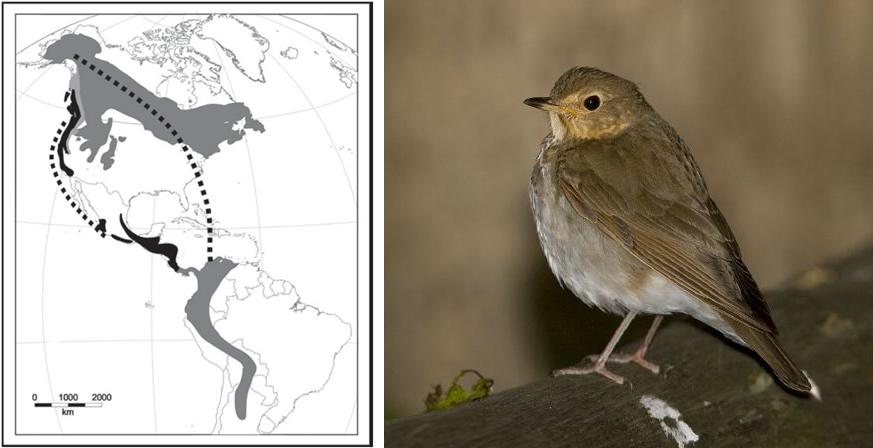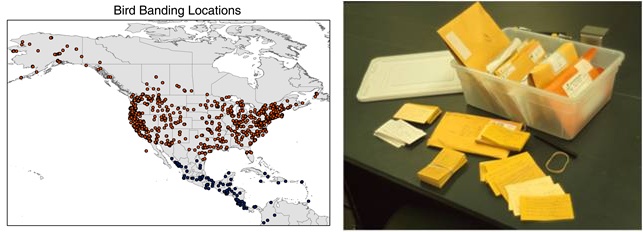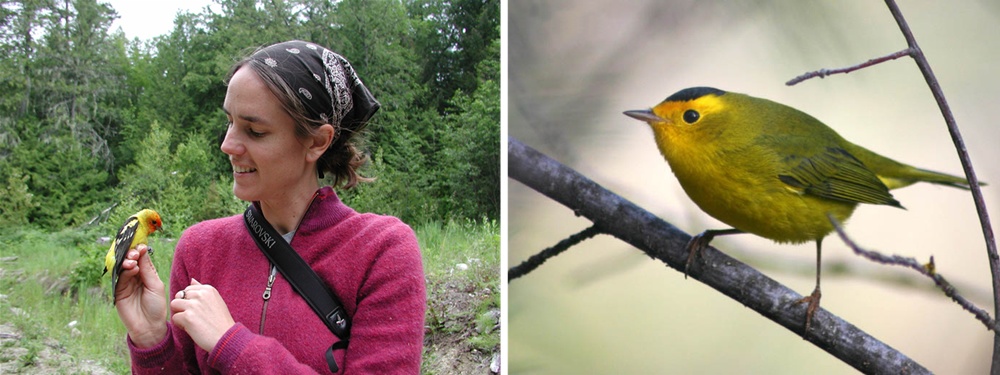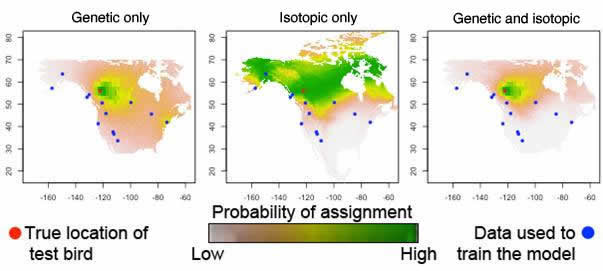Blog |
Connecting the Wintering and Breeding Sites of Migratory Songbirds Using New Isotopic and Genetic Methods
Scientists and birdwatchers alike have noted precipitous population declines in many species of migratory songbirds during the last thirty years. However, the transitory nature of migratory birds makes it difficult to pinpoint the exact cause of these declines. Some postulate that habitat loss on the tropical wintering grounds is the cause, while others suggest that forest degradation on the temperate breeding grounds may be negatively influencing reproductive success. Songbirds are also undoubtedly affected by disturbances along the migratory pathway at the many stopover sites upon which they depend. Without the ability to relate specific breeding and wintering populations and their associated migratory routes, developing effective management strategies remains elusive. Historically, efforts to correlate breeding, wintering, and migratory populations have relied on large-scale banding programs. However, these efforts have generally met with limited success because recapture of banded birds, especially on their wintering grounds, is rare.

In collaboration with Tom Smith, Director of the Center for Tropical Research (CTR), I have been helping to lead a team that has been developing an alternative method for tracking migratory movements of birds. Our team includes a combination of empirical scientists, statisticians, and on-the-ground field biologists from the University of California, Los Angeles, the University of California, Santa Cruz, the National Marine Fisheries Service, and the University of Oklahoma. Together, we have been developing biological tags that use genetic and isotopic information from a single feather to track where an individual was born and where it molted its feathers. As a consequence, a feather collected at one stage of the migratory cycle can be used to make essential links between where that bird may be going and where it came from.
During the past 20 years, CTR has accumulated more than150,000 feather samples from across the breeding and wintering range of almost 500 species of birds. Many of these feathers were collected with the help of the Institute for Bird Populations in Point Reyes, California and our other collaborators at bird banding stations all over North, Central, and South America. Our contributors operate bird-banding stations during wintering, breeding, and migratory periods. At each location, field researchers capture birds in mist nets, pull two outer retrices (paired tail feathers), then release the birds. The feathers are placed in small manila envelopes, the pertinent biological information is recorded, and they are shipped to CTR where they are cataloged and preserved for future use.

Until recently, the spatial scale for identifying where particular breeding populations spend the non-breeding seasons was too coarse to detect drivers of local population dynamics. However, our team has been leveraging recent advances in genetic and isotopic methods and developing novel statistical tools for combining both types of data. As a result, we are capable of defining where migratory birds winter and breed at a much finer spatial resolution. The implementation of isotopic methods, led by Associate Professor Jeffrey Kelly at the University of Oklahoma, consists of quantifying the ratio of different forms of elements in a feather that vary predictably with geography. As a result, each feather will have a distinct isotopic signature that provides information about where that feather was molted (birds can molt several times a year).
The genetic methods that I employ identify the breeding location of a particular individual using population-specific markers. By utilizing genome-wide sequencing techniques, I recently sequenced over one hundred thousand genetic regions from two target taxa, the Swainson’s thrush, Catharus ustulatus and the Wilson’s warbler, Wilsonia pusilla. In conjunction with Dr. Eric Anderson at the National Marine Fisheries Service, Southwest Fisheries Science Center, in Santa Cruz, California, I am currently analyzing these data. While our analyses are still preliminary, the results look very promising, suggesting thousands of population-specific markers exist for identifying breeding origins of birds.

When birds molt on the breeding grounds, the genetic and isotopic signatures yield two independent sources of information about breeding origins. Previously, there was no way to combine these two sources into a single analytical framework. However, recent statistical advances by two of our collaborators, UCLA Assistant Professor John Novembre and his graduate student Colin Rundel, have yielded important results. The most recent data indicate that when genetic and isotopic data are combined, we can identify the breeding location of birds with greater accuracy than when using either method independently. We now have the proof of concept needed to show that the combined data set provides a powerful method for identifying migratory connections.

Given the volume of genetic data that we are now able to generate with relative ease, it is likely that the development of biological tags will one day soon become a cost-efficient alternative to traditional bird banding methods of tracking migratory birds. It is our hope that the tools that we are developing, and the resulting information on migratory connections, can be used to help inform conservation decisions in the face of climate change, increased habitat loss, avian diseases, and other anthropogenic stressors.

Our work could not have been carried out without the help of Margery Nicolson, who contributed funds for the development of genetic tags using genome-wide sequencing. We are also grateful for grants from the Environmental Protection Agency and the National Science Foundation awarded to Tom Smith and John November.
